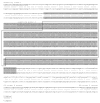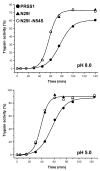Gene conversion between functional trypsinogen genes PRSS1 and PRSS2 associated with chronic pancreatitis in a six-year-old girl
- PMID: 15776435
- PMCID: PMC2752332
- DOI: 10.1002/humu.20148
Gene conversion between functional trypsinogen genes PRSS1 and PRSS2 associated with chronic pancreatitis in a six-year-old girl
Abstract
Gene conversion--the substitution of genetic material from another gene--is recognized as the underlying cause of a growing number of genetic diseases. While in most cases conversion takes place between a normal gene and its pseudogene, here we report an occurrence of disease-associated gene conversion between two functional genes. Chronic pancreatitis in childhood is frequently associated with mutations of the cationic trypsinogen gene (serine protease 1; PRSS1). We have analyzed PRSS1 in 1106 patients with chronic pancreatitis, and identified a novel conversion event affecting exon 2 and the subsequent intron. The recombination replaced at least 289 nucleotides with the paralogous sequence from the anionic trypsinogen gene (serine protease 2; PRSS2), and resulted in the PRSS1 mutations c.86A > T and c.161A > G, causing the amino acid substitutions N29I and N54S, respectively. Analysis of the recombinant N29I-N54S double mutant cationic trypsinogen revealed increased autocatalytic activation, which was solely due to the N29I mutation. In conclusion, we have demonstrated that gene conversion between two functional paralogous trypsinogen genes can occur and cause genetically determined chronic pancreatitis.
Figures



Similar articles
-
Mutations of human cationic trypsinogen (PRSS1) and chronic pancreatitis.Hum Mutat. 2006 Aug;27(8):721-30. doi: 10.1002/humu.20343. Hum Mutat. 2006. PMID: 16791840 Free PMC article. Review.
-
Interaction between trypsinogen isoforms in genetically determined pancreatitis: mutation E79K in cationic trypsin (PRSS1) causes increased transactivation of anionic trypsinogen (PRSS2).Hum Mutat. 2004 Jan;23(1):22-31. doi: 10.1002/humu.10285. Hum Mutat. 2004. PMID: 14695529
-
Gene conversion between cationic trypsinogen (PRSS1) and the pseudogene trypsinogen 6 (PRSS3P2) in patients with chronic pancreatitis.Hum Mutat. 2015 Mar;36(3):350-6. doi: 10.1002/humu.22747. Hum Mutat. 2015. PMID: 25546417 Free PMC article.
-
Hereditary pancreatitis caused by a double gain-of-function trypsinogen mutation.Hum Genet. 2008 Jun;123(5):521-9. doi: 10.1007/s00439-008-0508-6. Epub 2008 May 7. Hum Genet. 2008. PMID: 18461367
-
Gene conversion-like missense mutations in the human cationic trypsinogen gene and insights into the molecular evolution of the human trypsinogen family.Mol Genet Metab. 2000 Nov;71(3):463-9. doi: 10.1006/mgme.2000.3086. Mol Genet Metab. 2000. PMID: 11073713 Review.
Cited by
-
InTiCAR: Network-based identification of significant inter-tissue communicators for autoimmune diseases.Comput Struct Biotechnol J. 2025 Jan 10;27:333-345. doi: 10.1016/j.csbj.2025.01.003. eCollection 2025. Comput Struct Biotechnol J. 2025. PMID: 39897058 Free PMC article.
-
Familial pancreatic cancer.Arch Pathol Lab Med. 2009 Mar;133(3):365-74. doi: 10.5858/133.3.365. Arch Pathol Lab Med. 2009. PMID: 19260742 Free PMC article. Review.
-
Uncertainties in the classification of human cationic trypsinogen (PRSS1) variants as hereditary pancreatitis-associated mutations.J Med Genet. 2010 May;47(5):348-50. doi: 10.1136/jmg.2009.072751. J Med Genet. 2010. PMID: 20452997 Free PMC article.
-
Gene conversion causing human inherited disease: evidence for involvement of non-B-DNA-forming sequences and recombination-promoting motifs in DNA breakage and repair.Hum Mutat. 2009 Aug;30(8):1189-98. doi: 10.1002/humu.21020. Hum Mutat. 2009. PMID: 19431182 Free PMC article.
-
Mutations of human cationic trypsinogen (PRSS1) and chronic pancreatitis.Hum Mutat. 2006 Aug;27(8):721-30. doi: 10.1002/humu.20343. Hum Mutat. 2006. PMID: 16791840 Free PMC article. Review.
References
-
- Boocock GR, Morrison JA, Popovic M, Richards N, Ellis L, Durie PR, Rommens JM. Mutations in SBDS are associated with Shwachman-Diamond syndrome. Nat Genet. 2003;33:97–101. - PubMed
-
- Chen JM, Férec C. Gene conversion-like missense mutations in the human cationic trypsinogen gene and insights into the molecular evolution of the human trypsinogen family. Mol Genet Metab. 2000a;71:463–9. - PubMed
-
- Chen JM, Férec C. Origin and implication of the hereditary pancreatitis-associated N21I mutation in the cationic trypsinogen gene. Hum Genet. 2000b;106:125–6. - PubMed
-
- Chen JM, Férec C. Trypsinogen genes: evolution. In: Cooper DN, editor. Nature encyclopedia of the human genome. Macmillan publishers, nature publishing group; 2003. pp. 645–50.
-
- Chen JM, Kukor Z, Le Maréchal C, Tóth M, Tsakiris L, Raguénès O, Férec C, Sahin-Tóth M. Evolution of trypsinogen activation peptides. Mol Biol Evol. 2003;20:1767–77. - PubMed
Publication types
MeSH terms
Substances
Associated data
- Actions
- Actions
- Actions
- Actions
- Actions
- Actions
Grants and funding
LinkOut - more resources
Full Text Sources
Medical
Molecular Biology Databases

